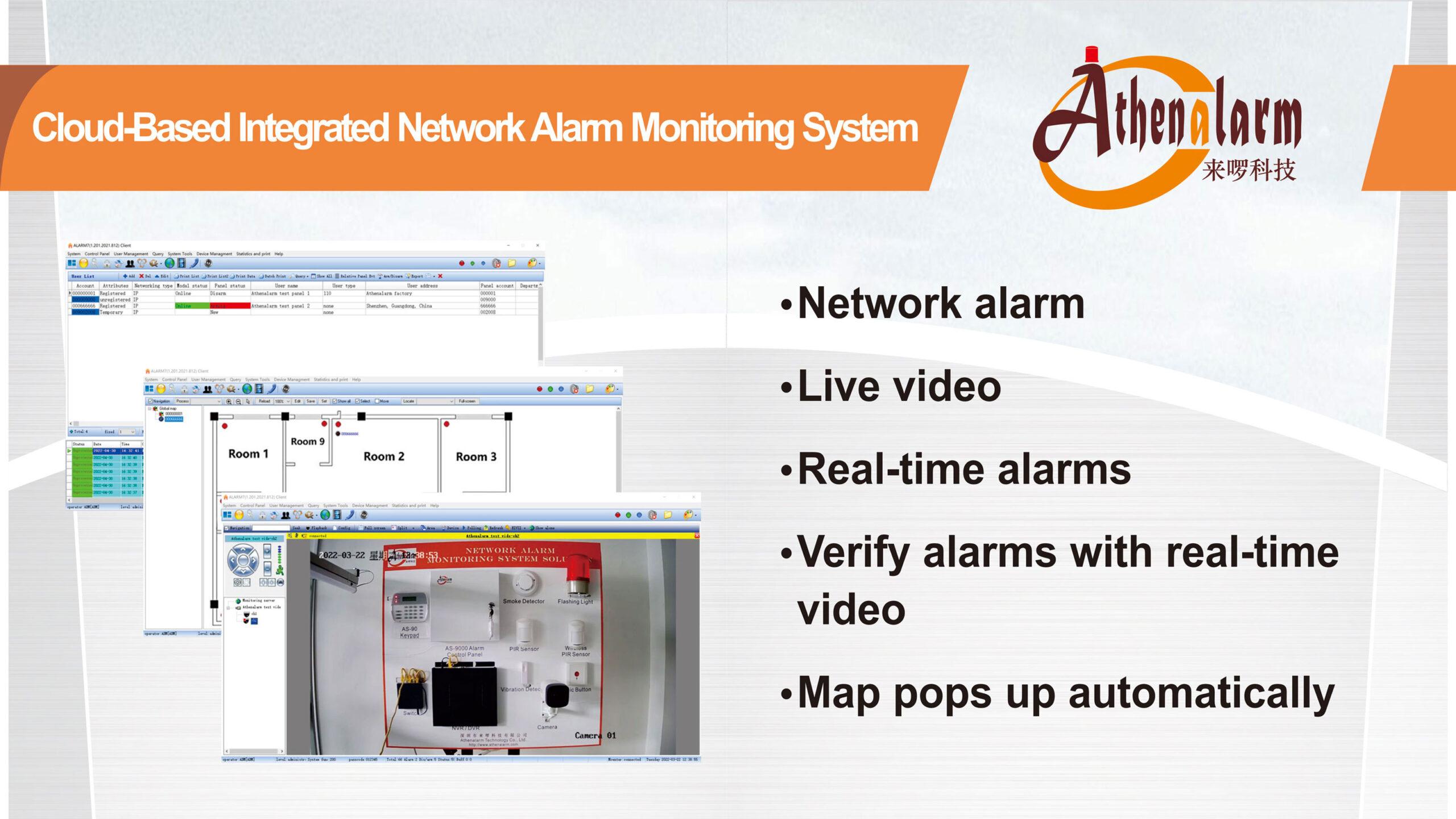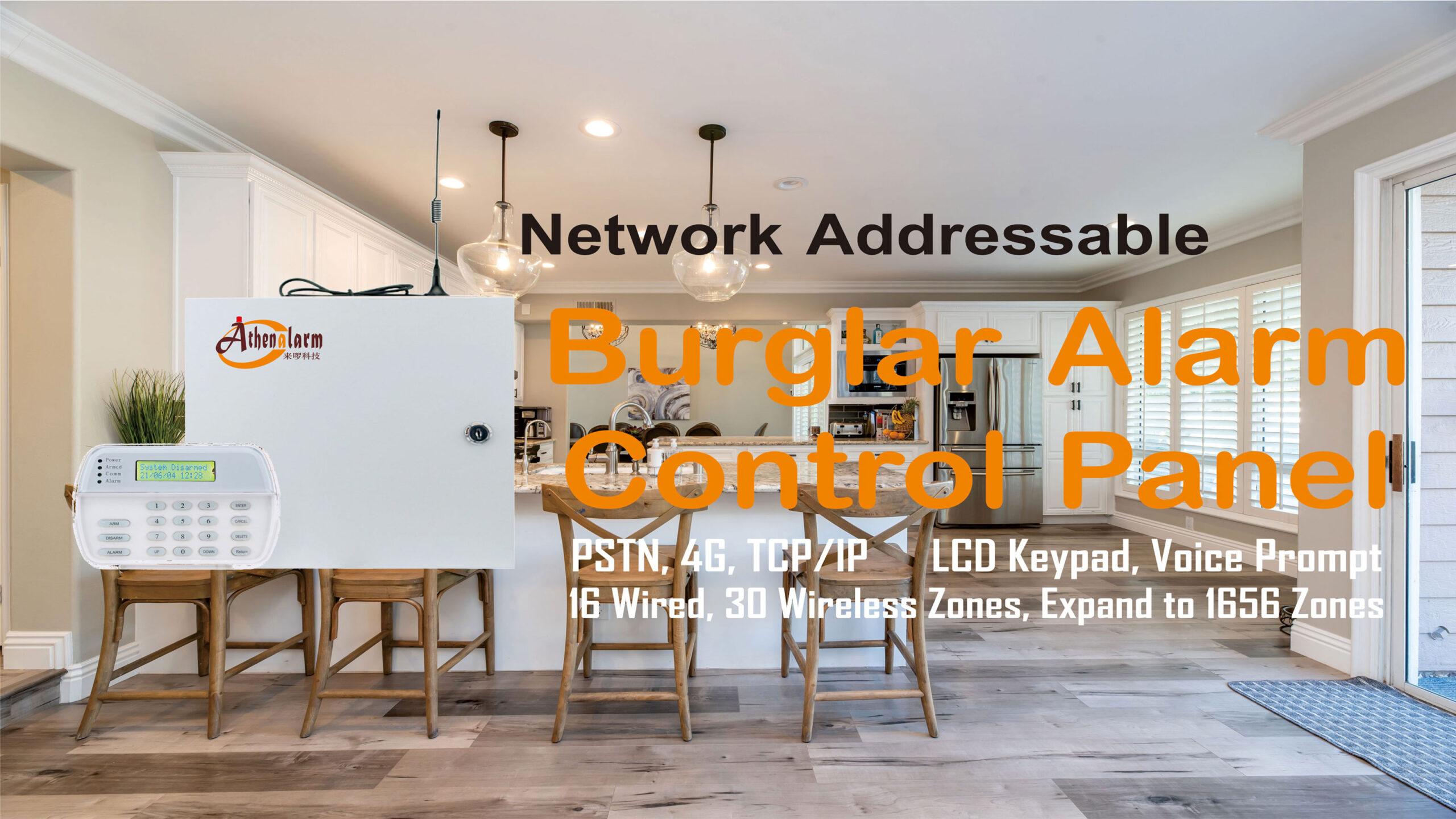



Burglar Alarm Basic Knowledge
1) What is an alarm control panel?
Answer: Alarm control panel: the “brain” part of the alarm system, which processes the signal of the detector, and provides arming and disarming operations through keypads and other devices to control the alarm system. It can provide sound/light prompts when alarming, and can also transmit alarm information to the alarm center through wires and wireless.
2) What parts does the alarm system consist of?
Answer: A simple alarm system consists of a front-end detector, an intermediate transmission part and an alarm control panel. Larger systems can also regard the detector and the alarm control panel as the front-end part, the transmission part between the alarm control panel and the alarm receiver, and the central alarm receiver as the back-end part.
3) According to the different information transmission methods of the alarm system, what types can it be divided into?
Answer: According to different information transmission methods, there are two types between the detector and the alarm panel: wired and wireless. From the alarm control panel to the central alarm receiver, it can also be divided into two types: wired and wireless. Among them, the wired system can also be divided into two types: subline-based transmission and bus-based transmission.
4) What are the common defense zone types of the alarm system?
Answer: The common ones include access defense zone, instant defense zone, internal defense zone, and 24-hour defense zone.
5) What is the access zone?
Answer: The entry and exit defense zone is also called the delay defense zone. After arming, the system will provide a certain delay time for entering and exiting the defense zone. After the delay time for going out, the delay zone system alarm will be triggered. When the delay zone is triggered when entering, the alarm control panel will emit a buzzer during the entry delay time as a prompt signal to disarm the system. The system must be disarmed within the set delay time, otherwise it will alarm. This zone type is suitable for the user’s entrance/exit operation keypad must pass.
6) What is an instant defense zone?
Answer: When the instant defense zone is triggered after the system is armed, it will immediately alarm without delay time.
7) What is an internal defense zone?
Answer: Internal defense zone: After the system is armed, if the entry and exit defense zone is triggered first and then the internal defense zone is triggered, the internal defense zone will also enter the delay state and will not immediately alarm. The delay time of this defense zone is consistent with the entry and exit defense zone. If the interior defense zone is triggered before the entry and exit zone is triggered, the system will alarm immediately.
8) What is the perimeter defense zone?
Answer: Perimeter zones are used for external doors and/or windows, and alarms are triggered immediately when the zone is violated.
9) What is a 24-hour defense zone?
Answer: The 24-hour defense zone is not affected by arming and disarming, and the alarm will be triggered immediately when the defense zone is triggered.
10) What is a 24-hour audible emergency zone?
Answer: 24-hour emergency zone with sound: It is a kind of 24-hour zone. When this type of zone is triggered, the external alarm lights and sirens will emit sound and light prompts, and the alarm will be displayed on the keypad. This type is suitable for panic buttons.
11) What is a 24-hour silent emergency zone?
Answer: 24-hour audible emergency defense zone: It is a type of 24-hour defense zone. When this type of defense zone is triggered, the external alarm lights and sirens will not emit sound and light prompts, and will not display alarms on the keypad. This type is suitable for emergency buttons in important places such as banks and jewelry counters.
12) What is a fire zone?
Answer: Fire zone: It is a kind of 24-hour zone. When the defense zone is triggered, it will send out a fire alarm signal, and the keypad will display the defense zone number and trigger the external siren to emit a special alarm sound. For use in 24-hour secured areas equipped with smoke detectors, heat detectors or panic buttons.
13) What is away arming?
Answer: Away arming: refers to a mode of arming the system when all users leave the protection area of the alarm system. In this mode, all defense zones in the system are in working state.
14) What is arming by staying?
Answer: Arming by staying: It refers to a mode of arming the system when the user is in the internal protection area of the alarm system is in the armed state. And the internal defense zone in the system (usually the infrared sensor installed indoors) will be automatically bypassed by the system, and internal personnel can automatically move in this area without generating an alarm.
15) What is disarm?
Answer: Disarm: means to make the alarm control panel exit the alarm state through password or key methods.
16) What is eliminating the alarm?
Answer: The system has an alarm during arming, and there is still a prompt on the keypad after disarming. To eliminate the alarm means to stop the alarm sound by operating again after disarming, and return to the disarming state.
17) What is entry delay?
Answer: Entry delay: It means that after a person enters the entry and exit defense zone outside, the entry and exit defense zone is triggered, but at this time the system will not alarm immediately, it is in the state of entry delay (usually tens of seconds). During this process, you must immediately disarm the alarm system correctly, otherwise the system will generate an alarm after the entry delay ends.
18) What is exit delay?
Answer: Exit delay: refers to the delay time (usually tens of seconds) left for the operator to leave the entry and exit zone after the system is armed. You must leave the entry and exit zone within this time, otherwise you will trigger the entry and exit zone after the delay ends.
19) What is bypass?
Answer: Bypass: When arming, one or some defense zones will not be added to arming.
20) What is the installer password?
Answer: It is a password for the installer, through which one can enter the system programming and set various items of the system.
21) What is the owner password?
Answer: The password used by system operators is the highest-level password among all operator passwords, through which the passwords of other users can be managed.
22) What is a duress password?
Answer: When the user needs to disarm the system under the duress of being hijacked by robbers, he can use this duress password to operate. At this time, it seems that the system is disarmed normally, but in fact the system will silently transmit a duress alarm to the center.
23) What is a dual-network alarm control panel?
Answer: The alarm control panel has dual communication functions of wired alarm and GSM, 3G, 4G wireless alarm. When the line fails, it can automatically transmit information through GSM, 3G, and 4G communication modules, and the two communication methods can also be used at the same time. The reliability of information transmission is greatly improved.
24) What are the advantages and disadvantages of wired/wireless alarm systems?
Answer: The detectors of the wired alarm system are connected to the alarm through data cables, and the alarm panel to the alarm center adopts wire or bus transmission. The wired alarm system has low cost, high reliability, and convenient maintenance, but it has disadvantages such as long construction period and large engineering quantity. It is suitable for places that do not require high environmental beauty.
25) What are the types of detectors? What types are common in the market?
Answer: PIR motion, microwave, vibration, smoke, gas, glass, pressure, ultrasonic, etc. Among them, PIR motion sensors can also be divided into active infrared and passive infrared, and smoke detectors can also be divided into ion type and photoelectric type. The common ones on the market are PIR motion sensors (passive infrared), through-beam, fence (active infrared), dual-screen detectors, vibration detectors, and glass detectors.
26) How does the active infrared detector work?
Answer: The active infrared detector consists of an infrared emitter and an infrared receiver. The infrared emitter emits one or more modulated infrared rays to the infrared receiver. When there is no obstruction between the transmitter and receiver, the detector will not alarm. When an object is blocked, the output signal of the receiver changes, and the detector alarms.
27) What is the working principle of passive infrared detector?
Answer: There are two key components in the passive infrared detector, one is the Fresnel lens and the other is the pyroelectric sensor. Any object with a higher temperature (-273°C) in nature will produce infrared radiation, and the wavelengths of infrared energy released by objects at different temperatures are also different. The human body has a constant body temperature, which differs from the temperature of the surrounding environment. When the human body moves, the change of this difference is detected by the pyroelectric sensor through the Fresnel lens, thereby outputting an alarm signal.
28) How does the microwave detector work?
Answer: Microwave detectors use the principle of the Doppler effect. In the microwave section, when transmitting at a certain frequency, when the emitted microwave encounters a fixed object, the frequency of the reflected microwave remains unchanged, that is, f sending is equal to f receiving, and the detector will not send out an alarm signal. When the emitted microwave encounters a moving object, the frequency of the reflected microwave will change, that is, f sending is not equal to f receiving, and the microwave detector will send out an alarm signal at this time.
29) What is a dual-element infrared detector? What is a quaternary infrared detector?
Answer: A detector that integrates two pyroelectric sensors with the same performance and opposite polarity is a binary detector. A detector that integrates four pyroelectric sensors with the same performance and opposite polarities is a quaternary infrared detector.
30) What is the function of Fresnel lens?
Answer: The Fresnel lens has 2 functions. One is to refract or reflect the pyroelectric infrared radiation to the pyroelectric sensor, and the other is to divide the detection area into several bright areas and dark areas. When the human body moves within the detection range, it will enter the Fresnel lens in turn. The pyroelectric sensor senses the moving human body for a while, and then fails to sense it for a while, so that the movement of the human body can generate continuously changing signals on the pyroelectric sensor in the form of temperature changes.
31) What is dual detection detector? What are the common dual detection detectors on the market?
Answer: In order to overcome the defects of single-technology detectors, two detectors with different technical principles are usually integrated together, and only when the sensors of the two detection technologies detect human body movement, the detectors that alarm are called dual detection detectors . Most of the common dual detection detectors on the market are microwave + passive infrared, and there are also infrared + air pressure detectors and audio + air pressure detectors and other products.
32) What is triple detection detector? What is quadruple detection Detector?
Answer: In order to further improve the performance of the detector, on the basis of the dual detection detector, a detector with microprocessor technology is added, which is called the triple detection detector. On the triple detection detector, another technology detector is added, called the quadruple detection detector.
33) What is a vibration detector?
Answer: Vibration detectors are used to detect the vibration signals generated by intruders for various sabotage activities as the basis for alarming. For example, when intruders are carrying out sabotage activities, such as chiseling walls, drilling holes, and prying safes, these objects will cause vibrations. Detectors that trigger alarms with these vibration signals are called vibration detectors.
34) What kinds of common vibration detectors? How do they work?
Answer: According to the different vibration sensors used, vibration detectors can be divided into: mechanical vibration detectors, inertial rod electronic vibration detectors, electric vibration detectors, piezoelectric crystal vibration detectors, electronic comprehensive vibration detectors, and many other types. Recently, piezoelectric crystal vibration detectors are mostly used, and the principle is to use the piezoelectric effect of piezoelectric crystals. Piezoelectric crystal is a special kind of crystal, which can transform the mechanical force applied on it into an electrical signal of corresponding magnitude. The frequency and amplitude of the electrical signal are proportional to the frequency and amplitude of mechanical vibration. When the signal value reaches the set value, an alarm signal is issued.
35) How does the glass breakage detector work?
Answer: When the glass is struck and the glass is not broken, an ultra-low frequency elastic vibration wave will be generated. This mechanical vibration wave is lower than 20Hz and belongs to infrasonic wave. The frequency of the loud and piercing sound emitted when the glass is broken is in the range of 10-15KHZ, which belongs to high-frequency sound. When the detector detects two sound frequencies of low frequency and high frequency at the same time, an alarm signal will be generated.
36) What is the standard output signal of the detector?
Answer: The standard output signal of the detector is a switch signal, with normally open, normally closed, and normally open/normally closed options.
37) What is temperature compensation?
Answer: In general, human body temperature is always much higher than the ambient temperature. When the intruder moves, the sensor receives a large change in the infrared signal and triggers an alarm. When the temperature of the surrounding environment rises to be close to the temperature of the human body, the amplitude of the infrared change signal received by the sensor, when the intruder is moving is very small, so it is possible that the alarm will not be triggered because the signal is less than the trigger threshold. Temperature compensation can automatically increase the gain of the intruder signal amplifier, when the ambient temperature is close to the human body temperature, so that the signal of the external intruder can be captured and the sensitivity will not be affected by the ambient temperature.
